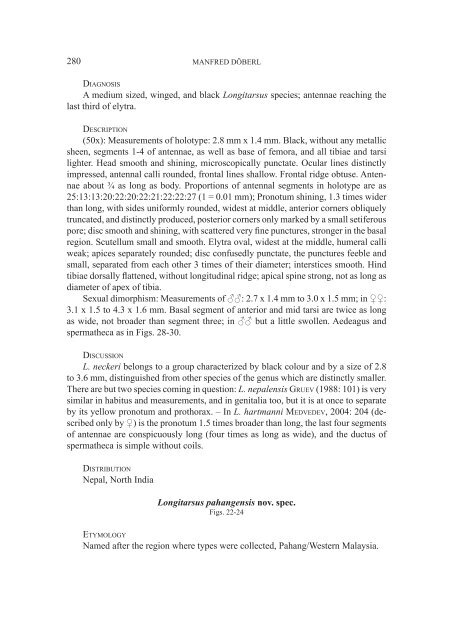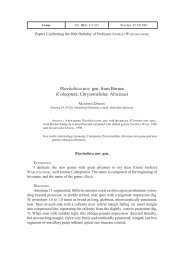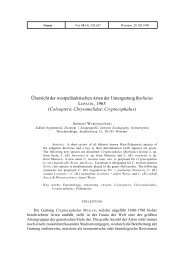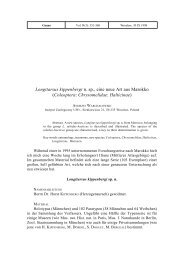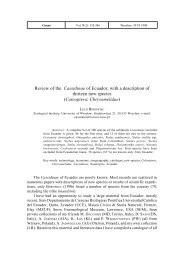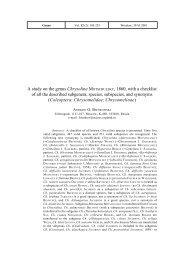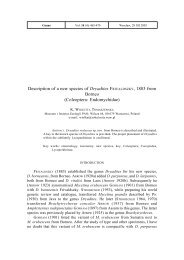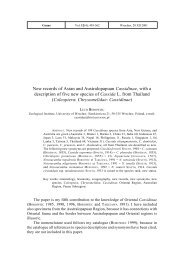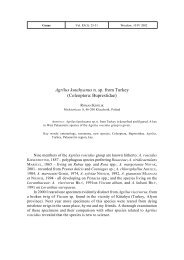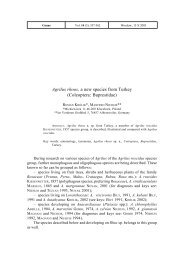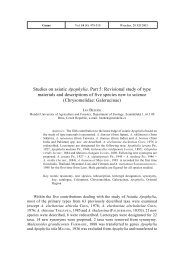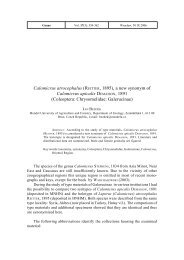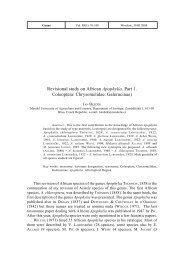New Alticinae from China and southeastern Asia (Coleoptera ...
New Alticinae from China and southeastern Asia (Coleoptera ...
New Alticinae from China and southeastern Asia (Coleoptera ...
Create successful ePaper yourself
Turn your PDF publications into a flip-book with our unique Google optimized e-Paper software.
280 MANFrED DöBErL<br />
diagnosis<br />
A medium sized, winged, <strong>and</strong> black Longitarsus species; antennae reaching the<br />
last third of elytra.<br />
description<br />
(50x): Measurements of holotype: 2.8 mm x 1.4 mm. Black, without any metallic<br />
sheen, segments 1-4 of antennae, as well as base of femora, <strong>and</strong> all tibiae <strong>and</strong> tarsi<br />
lighter. Head smooth <strong>and</strong> shining, microscopically punctate. ocular lines distinctly<br />
impressed, antennal calli rounded, frontal lines shallow. Frontal ridge obtuse. Antennae<br />
about ¾ as long as body. Proportions of antennal segments in holotype are as<br />
25:13:13:20:22:20:22:21:22:22:27 (1 = 0.01 mm); Pronotum shining, 1.3 times wider<br />
than long, with sides uniformly rounded, widest at middle, anterior corners obliquely<br />
truncated, <strong>and</strong> distinctly produced, posterior corners only marked by a small setiferous<br />
pore; disc smooth <strong>and</strong> shining, with scattered very fine punctures, stronger in the basal<br />
region. Scutellum small <strong>and</strong> smooth. Elytra oval, widest at the middle, humeral calli<br />
weak; apices separately rounded; disc confusedly punctate, the punctures feeble <strong>and</strong><br />
small, separated <strong>from</strong> each other 3 times of their diameter; interstices smooth. Hind<br />
tibiae dorsally flattened, without longitudinal ridge; apical spine strong, not as long as<br />
diameter of apex of tibia.<br />
Sexual dimorphism: Measurements of ♂♂: 2.7 x 1.4 mm to 3.0 x 1.5 mm; in ♀♀:<br />
3.1 x 1.5 to 4.3 x 1.6 mm. Basal segment of anterior <strong>and</strong> mid tarsi are twice as long<br />
as wide, not broader than segment three; in ♂♂ but a little swollen. Aedeagus <strong>and</strong><br />
spermatheca as in Figs. 28-30.<br />
discussion<br />
L. neckeri belongs to a group characterized by black colour <strong>and</strong> by a size of 2.8<br />
to 3.6 mm, distinguished <strong>from</strong> other species of the genus which are distinctly smaller.<br />
There are but two species coming in question: L. nepalensis gruev (1988: 101) is very<br />
similar in habitus <strong>and</strong> measurements, <strong>and</strong> in genitalia too, but it is at once to separate<br />
by its yellow pronotum <strong>and</strong> prothorax. – In L. hartmanni Medvedev, 2004: 204 (described<br />
only by ♀) is the pronotum 1.5 times broader than long, the last four segments<br />
of antennae are conspicuously long (four times as long as wide), <strong>and</strong> the ductus of<br />
spermatheca is simple without coils.<br />
distribution<br />
Nepal, North India<br />
Longitarsus pahangensis nov. spec.<br />
Figs. 22-24<br />
etyMology<br />
Named after the region where types were collected, Pahang/Western Malaysia.


